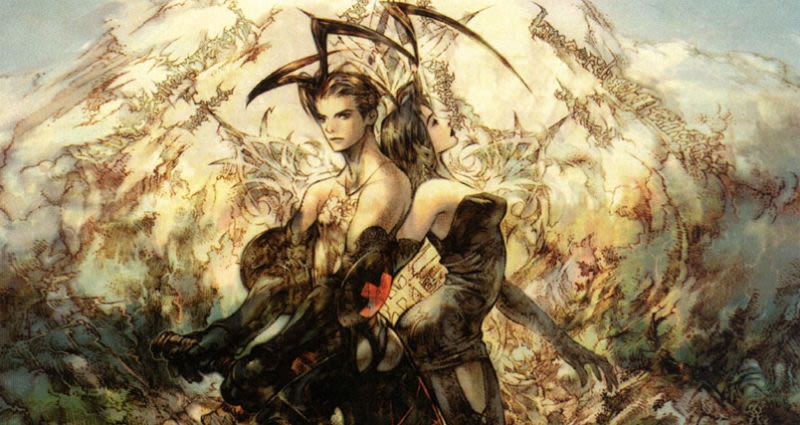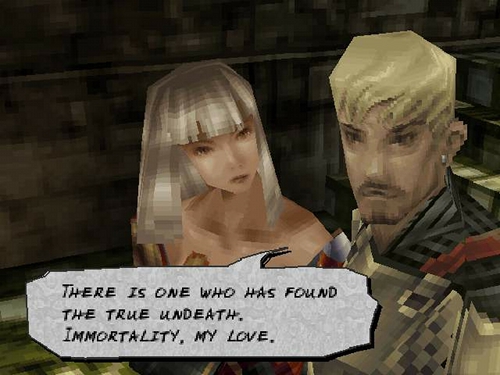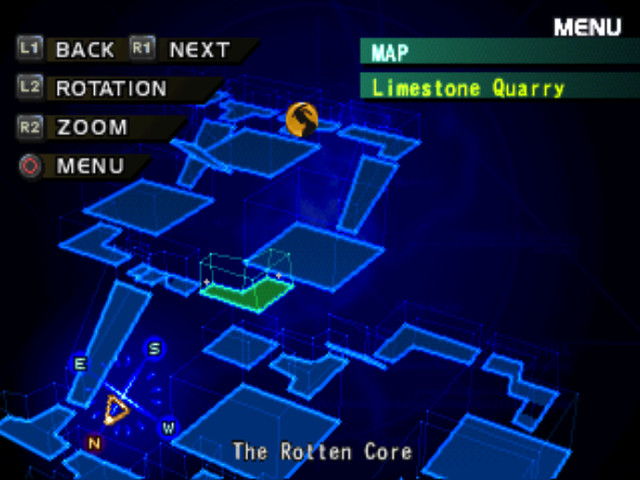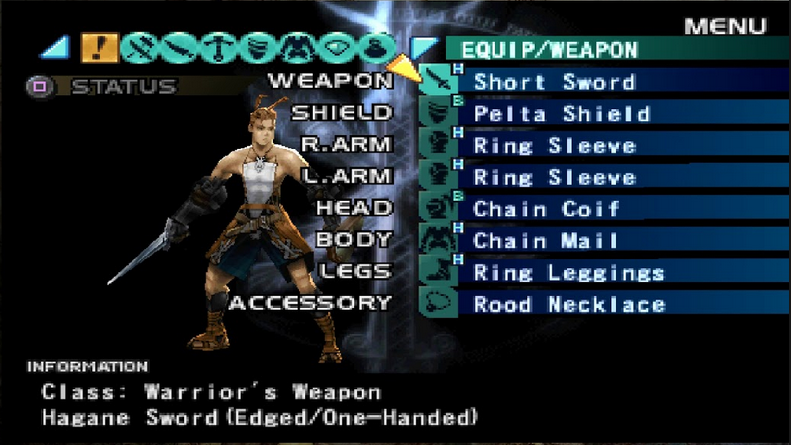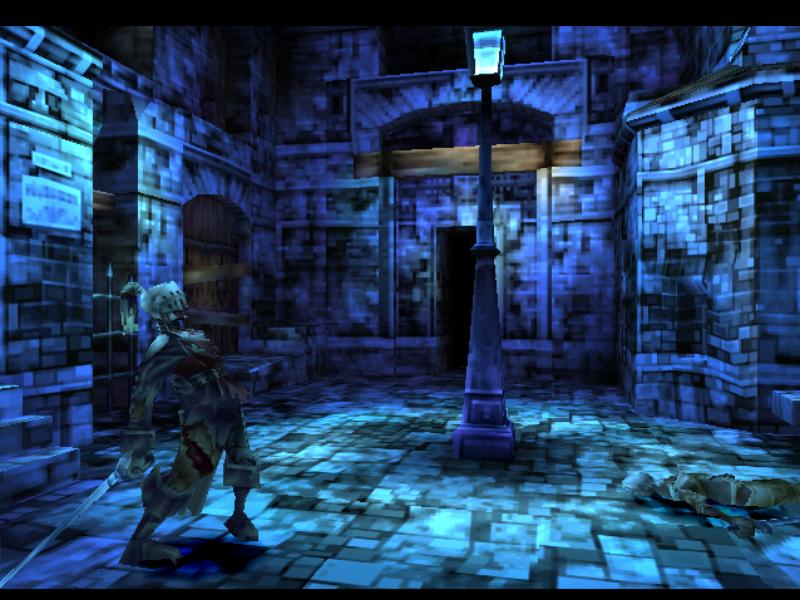Game Name: Vagrant Story (2000)
Developer: Square Enix (Final Fantasy, Dragon Quest, Kingdom Hearts)
Platform: PS1, Vita (reviewed on Vita)
Categories: Grand Cinematography, Interesting Characters, Attractive Artstyle, Labyrinthine and Mysterious Dungeon, Intricately Gritty Story, Real Time RPG, Pausable Battles, Isometric, Weapon/Armor Melding, Equipment Affinity, Cube Puzzles, Halberds, Dragons, ye Olde English, High Fantasy, Dark Magic, Risk/Reward, Chained Combos, Powerful Growth and Progression, Item Management, Ambitious, Formidable
May Appeal To: Ivalice completionists, Akihiko Yoshida fans, dungeon divers, monster slayers, weapon crafters, game design students, dialogue skeptics, Archers, Berserkers, Black/White/Red Mages, Chemists, Dark Knights, Mage Knights, Dragoons, Fighters, Gamblers, Monks, Paladins, plain ol’ Warriors, and spatial puzzle Wizards.
May Repulse: puzzle haters, challenge shirkers, Squeenix detractors, the disorganized, the immethodical, people prone to getting lost, and fashion critics of ass-less chaps.
Comparable To: Parasite Eve + Fullmetal Alchemist + Disgaea in a blender. It has combat from the first, the second’s setting, and visual/gameplay elements from the third. Newer Fallout players will draw correlations to the Vault-Tec Assisted Targeting System, specifically that you freeze time and target an enemy’s unlucky body part. The map draws parallels with a horizontally-oriented MetroidVania; the character design is distinct to Square’s Final Fantasy XII or Tactics Ogre; and Shadow Hearts Covenant’s timing and puzzles are in the forefront of my mind once more. Diablo II’s gradual -and irreversible- leveling system as well as Monster Hunter’s focus on personal knowledge and equipment affinity vs numerical player levels are both relevant.
Learning Curve: I’d say 3 hours to see the various elements the tutorials cover.
Game Length: 35 Hours
Difficulty: Block Puzzles, Combat, and Equipment Leveling – all mid-to-high individually.
Mastery: The meat and potatoes of the experience. Since Ashley uses so little of his available skills (depending upon a given playstyle) and the game locks high-tier abilities behind an “unflexed muscles don’t develop” philosophy, mastering all aspects of the exploration, combat, equipment crafting, bestiary, secret chests, and time trials is quite the test. And this is a game developed before achievements added arbitrary busy work.
Story: Upon booting, the player is greeted by the spellbounding gyrations of dancer-priestess Müllenkamp, a figure whom not only founded the successful bridging of those occupations but also a cult in worshiping dark magic, ages past. Within this most accessible of history lessons, astute players notice a familiar tattoo and the casual, almost careless, abutment her jump shots are to a fire breathing wyvern, a creature of ancient mythology in this world. A warrior suits up to answer an early summons.
Duke Bardorba’s Manor, 2:30am. A massive inferno breaks out as antagonistic forces assemble on the most unlikely of battlefields. Guildenstern’s “Crimson Blades”, knights in direct service to the Cardinal, work tirelessly to extinguish the lives of the religious Müllenkamp followers, whose drab robe-clad forms fall effortlessly before practiced, drilled precision. Ruffians, rabble, they serve Sydney Losstarot, a half-naked warlock with intimidating, mechanical claws searching fervently and with haste for some unnamed object. He has swept even the elderly Duke’s family into the foray, bystanders/hostages in a war not their own. A third party, agnostic to the squabbles of any particular religion, mobilizes at the strained behest of the manor’s occupants. It is parliament’s special forces, the Valendia Knights of Peace, whom you represent – Ashley Riot, “Riskbreaker”, an elite infiltration soldier deemed “cat’s paw” for controlling the situation involving Sydney, the “self-styled prophet of the apocalypse”.
Ashley deliberately seals the perimeter gate, penetrates the inner sanctum (easily disposing or eluding the Müllenkamp obstacles as they arise), and surprises the cult’s leader with a crossbow bolt to the heart, seemingly terminating the game’s struggle prematurely. But nothing is as it seems, the tattooed Sydney rising pained from the grave, extricating the arrow’s shaft and beckoning his 2nd in command, Hardin, to flee to Leá Monde with the unconscious, blonde Bardorba heir in tow. Sydney exerts focused, channeled power in spades, the wispy, bleeding wretch calling forth a wyvern to shatter the ceiling as he slumps forward in stumbling out the cathedral’s highest stained glass window. Ashley now squares off against the dark mastermind’s nightmarish reptile familiar, bloody spears erupting from its many existing wounds.
Given Duke Bardorba’s influence to both the governing body, parliament, and whispered associations to Müllenkamp, what indeed is the true intent of all factions swarming this playfield? Leá Monde was once a bustling city within a fortified island. Due to natural earthquakes that buried its citizenry, obliterated contiguous roads, and created a maze of switchback tunnels what could possibly lie in wait from this foreboding wellspring of blasphemous energies and rampant rumors? As the VKP’s most powerful agent seeks to pursue and prevent the organized criminal elements from achieving their goals, he has few allies and many, many questions.
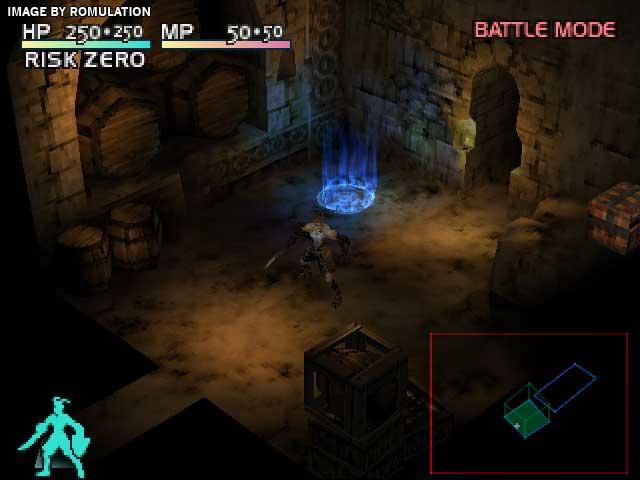
Save circle, storage container, health, map, and RISK – check, and double-check. Hoo boy, we ready for this?
Presentation: Vagrant Story is a 1st Generation Playstation game, which boasts an underwhelming 34mhz processor and 640×480 resolution maximum. That being said, the graphical and audible experience is absolutely amazing and this game stands resolute as a stoic, unsung contender for the ultimate this platform had to offer. Unlike many modern games, this is a true-to-vision realization orchestrated by artists limited by technology instead of technology artificially enabling a creatively bereft project. Just find room in your heart to forgive the occasional framerate dips, particularly in first person “room view” mode or during particularly violent spell effects.
The character exuded by low-poly models, impressively efficient bitmaps, deft lighting, sweeping symphonies, expert pacing, cinematic angles, spell effects, mysterious story unraveling, and overall breadth of the experience shames even Final Fantasy VII, which released only 3 years earlier on the same system.
Leá Monde is an enigmatic and fascinating setting, beholden to scores of progenitor dungeon crawlers that preceded it. Looping forests, crumbling open-air streets, subterranean underworlds bathed in blue, caverns echoing with the pounding of hooved beasts, cobblestones beset by clanking knightly armor, the clatter of swords in the gloom, squeals of vampire bats descending unseen, the tremolo crackle of a spell illuminating both the black rooms and a troubled past of the ill-fated island – the presentation culminates into a vivid and surrealistic sinking fortress rent asunder long ago, begging to be explored. It is an inexplicable experience of darkness and mystery, despite being colorful, magical, and paradoxical in its contradicting traits of invitational dread. Peel back the city’s layered personality in pursuit of Sydney and his unholy defenses.
The classy refined character designs may seem familiar, especially if Final Fantasy XII, FFXIV, FF Tactics, Tactics Ogre, or Bravely Default are in your gaming library. Akihiko Yoshida is back at it again with his half-lidded cherubs looking perturbed and distinguished, an almost pure and angelic vision of how fantasy heroes are storied to be. Here, the veneers mask cruel intentions, schemes, corrupted innocence, as the sneering actors posture and intimidatingly move against the opposing chess pieces. All cinematics -save the intro- utilize the in-game models, which doubly serves the consistency of the presentation and smooths the transitions into and out of the inevitable combat.
Dialogue bubbles are an appropriate choice, both to complement the comic book style of vivid colors framed in black but also as a workable alternative to voice acting. I hope you can tolerate low-slung angles of male assets in leather speedos though, since the tailor had an evident preference and nobody second-guessed his work!
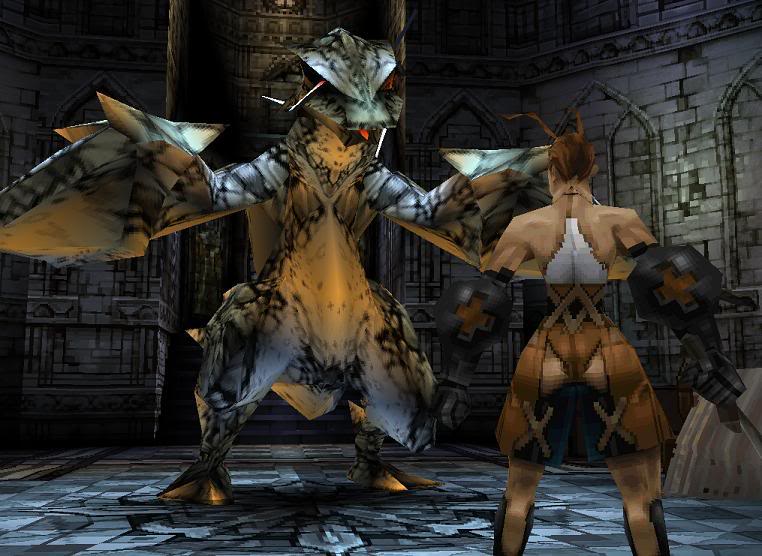
“Nah, just a mangled wifebeater and ass-less boy shorts for me thanks.” -Ashley Riot, an MVP for the VKP in VS
Unique Features: Jaded from years of games with roided-out masculine grunting, tacky and childish puns, or horrifically funny Engrish translations, I’m certainly biased when it comes to natural dialogue and prose. Vagrant Story sets a high bar even for a well-localized Square Enix game. Furthermore, it’s deployed in a way that is thoughtful and less stodgy than expected, almost Shakespearean in wit and delivery.
The very island is a conduit for dark magical energies in connecting humans via tele-empathy, sharing memories, embellishing latent powers, and coalescing into maligned enemies out of thin air. Having this much personality in the environment itself is fun, interesting, and unique. Maps are transverse passages of oblong and omniform shapes, innumerable rooms with names and phrases that hint at sordid and engrossing histories (a history never explored beyond reading their titles in sequence). Snowflies, earthquakes, autonomous blocks. It all feels like the player is caught in some grand, throbbing machine – a rich illustrious game setting with few rivals.
Gameplay: Pick a door to step through, identify a monster, equip your weapon for thrashing that monster type, string a chain of combos, get hit, dance outside their range bubble, re-apply some buffs, go for the kill, gain weapon affinity, loot the room, repeat. Superficially, this pattern is somewhat recognizable but if I emphasize the painstaking evolution of your handcrafted equipment even if you’re not paying attention and that destroying an enemy through massive combos leaves you wide open to more damage, it becomes a whole other monster of a system.
Ashley Riot lives and dies by his equipment, both defensive and offensive, and half of the game’s fun is in becoming a versatile weaponmaster with the right tool for any situation -tools you forge, meld, and train to have affinities. Having blunt, edged, and piercing strengths comes as no surprise. As do the fundamentals of the various materials: wood, leather, bronze, iron, hagane, silver, damascus, all of which produce a scale of intelligence (casting) and strength (smacking) bonuses.
In not so many words though, your hammered carapace and wielded weapons have become living things through the dark energies of Leá Monde, awakened to preferences in supping specific blood sources, conditioned in effectiveness against particular types. You face humans, phantoms, beasts, dragons, undead, and evil in your combative excursions, those endowed with air vs earth, fire vs water, light vs dark, and physical affinity. As you wail on enemies and as you receive wailings, a discreet +/- modifier pops up sporadically to reveal a specific piece of equipment’s tendency changing. This alone, would be enough to indicate an enemy’s type and affinity though casting a grimoire against them summarizes enemy analytics as well. Don’t worry, a bunch of this is new to even Ashley.
For the first time in his life, the character is introduced to the existence of magic. Being at the heart of this dark wellspring allows exposure to 40+ collectable grimoires which are then recited from memory at the cost of MP. Sorcerer, enchanter, warlock, and shaman spells are available, each focusing on a different aspect of application whether it be buffs, direct damage, or various out-of-combat effects such as “unlock”. Thankfully teleportation arrives mid-game, right around when navigating the 30+ save points becomes difficult (even then, distance is based on MP and you could wind up ambushed at a dangerous node if caught unawares).
Combos – the best way to stack mad damage upon an unlucky foe. Weapon types have unique animations that allow for downtime between strikes -in which an onscreen “!” appears and the player presses one of three mapped buttons to execute that chosen combo link. This might be a ‘+70% Damage’ or ‘Gain HP’ dependent on the mapping. Defending against strikes is similarly structured; a deft use of ‘Reflect 50% Damage’ or ‘Absorb MP’ can easily turning the tide in an uphill struggle.
You are a Riskbreaker, a one-man army defying all odds. True to concept, managing risk comes in the form of chaining combos and either pulling back or consuming items before resuming the assault. The more you attack, the higher the RISK. More RISK = higher crit chance, your lower hit chance, more damage taken, and easier crits against you. Adept at chaining combos? Great, don’t screw it up at the higher links in the chain. Of a possible 100 RISK, you’ll get about 30 from the first 8 or so combos, after which the gains are parabolic and end up filling your meter in about 15 successful blows. At 50+ risk you’re bound to have a 0% to-hit penalty and boss enemies frequently suffer 0 damage if you even land the blow. Sure, you could kill with a thousand 1 damage papercuts but I’m willing to bet most would rather foster a situation where enemies are magically weakened and then deconstructed with their affinity weakness, just like a puzzle.
Did you think Vagrant Story was going to let your cerebral cortex stagnate? No, this is by and large a “thinking person’s beat-em-up RPG”. Tactics, planning, and overcoming obstacles manifests itself in many game aspects, no slacker of which are the physical cube puzzles. With only scant “gimmes”, the isometric block positioning challenges are nothing to laugh at, more than two of them daring me to look up the answer on occasion. Magnets, repulsor blocks, slippery blocks, destructables, stone, numerical pushovers, mobile, etc. some puzzles are even timed to avoid the room’s cave-in. These and the time trials don’t necessarily suit the brooding reclusivity in theme but are welcome breaks to some of the more tedious backtracking and always-alert enemy interactions.
Observant players will even find secret panel runes, hidden chests, and time-saving passages should they be diligent and methodical enough.
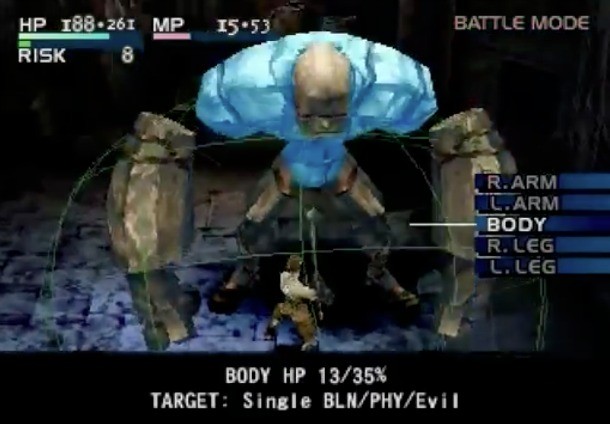
Go for the mouth, the throat, his vulnerable spots! Or construct a weapon. Can you form some sort of rudimentary lathe?
Additional Comments: I once printed every page of the map and made a comprehensive floor arrangement to get an idea of what the island looked like. A single hallway is misaligned from normal cardinal directions though this maze does have an interesting and legitimate Alcatraz feel to it. The organized pieces fit – it’s just unfortunate you never witness an official layout that arranges the disparate city sections to assist navigation.
What I Liked: The story regarding martyrs, prophets, hidden organizations vying for supremacy and the cast of characters, which are fully realized. I love the combat, the arduous battle preparation, the obscure conditions for mastery, the steady deliberate and permanent nature of equipment progression, and the lack of abridged mechanics which makes this title less accessible. Stodgy, old school gamer or not, I also find the graphics, music, and cinematography astounding – in or out of its natural time period.
And just look at this disambiguated, noncontextual, wonderful dialogue! LOOK AT IT!
“In my dreams, I see an evil tyrant’s hands which would choke the world. And he is the only one blind to his own folly.”
“A tyrant always dies alone, Guildenstern. Surrounded by silver-tongued leeches, he is utterly alone. He sows sorrow and reaps death.”
“I name you … “Worm”, as you crawl through the dust.”
“Those who crave the Dark cannot control the Dark.”
“Have a bit more respect for faery tales, Riskbreaker.”
“The Dark is formless and invisible. It invades the body like a plague, an unseen visitor. Yet those it taints become… undying.”
“What is death? Is it the ruination of the flesh? Surely, that is death, but it is only one facet of the truth. True death… is the death of the soul.”
Pure poetry. The game is chock full of the stuff.
What I Disliked: Armor is not rendered visually, only weapons; I spent half the game in workshops and would have appreciated my crafty labors bear fruit.
Backtracking with intention is fine. Backtracking when lost is not. For better or ill, there is no waypoint system and nothing about the experience holds your hand.
Just keep skimming those map screens for the word “unlockable”, I suppose.
*Convoluted, outdated, and sluggish inventory management via containers.
*Limited equipment carry capacity, especially at the end when you have favored weapons.
*No “from pouch/box” feature when melding and assembling weapons.
*Excruciating 20 second loading screens during container access or session save/load.
*Container access requires saving and disrupts any momentum you have. What a chore.
*Item access is in no discernible order, even on repeat viewings of the same page.
*Rafters and other foreground elements occlude the action and timing.
*Combos are highly dependent on seeing impact – impossible with larger enemies.
*There are formulas, sure, but equipment melding is trial-and-error without foreknowledge.
Glitches Experienced: None. Thanks Vagrant Story!
Hours I Played: ~75 on two playthroughs
My Personal Reaction: The “success by inches” design is a fantastic approach to a game like this, a slow burn that series such as Diablo and -to a lesser degree- Monster Hunter have recognized. The Souls series notwithstanding, meticulous and oppressive environments that pose a very real threat simply aren’t as popular these days and you’re less likely to run across a gem with stellar production values, engrossing story, and with puzzle and timing elements that prove both mentally and physically challenging – with stats and a massive inventory to boot. Vagrant Story is a meaty experience that, start to finish, remains an exciting, eventful, and cinematic celebration of the “heyday” of older gaming conventions and the budding experimentation that would later spawn its own sub-genres.
A lot of love and attention to detail went into this game and the English localization, combat progression, story, presentation, and pacing are some of the best I’ve ever seen.
Noob Tips:
*Read the in-game tutorial, twice if it doesn’t sink in. Three times the charm?
*No one’s watching. Just use an online chart to save headache with weapons melding.
*Tarnish + Degenerate + Herakles + Prostasia – the winning combo to most battles.
*Jump around to delay the enemy turn. Unlike you, they can’t hit targets in mid-air.
*7-9 successive combos is the sweet spot to proper RISK management, in my opinion.
*AOE magic works best against enemies with multiple parts. Finesse that targeting bubble towards the center torso for maximum blinkage.
*Sheathe your weapon when not in use: You regenerate HP/MP faster, lower RISK, and the weapon’s power points don’t drop off. (Doing this mid-battle is especially tactical.)
*No single weapon does it all. Evolve 3 to 5 weapons against specific enemy types and combine extraneous equipment so as not to nullify any natural gains.
*Learn to love weapons with a wider bubble, and get acclimated to their distinct chain attack timings, potentially unlocking a devastating Break Art given enough successes.
Is it possible to blunder through Vagrant Story without knowing wtf you’re doing and disregard the key mechanics I’ve discussed? Absolutely, I’ve done it at least once.
Depth and Replayability: Very High Depth, Limited Replayability (?) – it is an RPG after all. The lengthy storyline and repetitive battles would normally have me discredit a title from a second playthrough, but here I am. There’s just something rare and appealing about this game’s alchemy that enticed me for another go ’round: varied equipment builds, esoteric leveling, nuanced magic casting, and tricky combo timing. The substantial player growth throughout this experience just begs for further challenge and a fresh start to prove one’s prowess on a “redo”. Should someone get stuck in the labyrinth on a first run, however, I foresee a scenario where no further challenge is required.
Suggested Value: $40
Where to Buy: Amazon, eBay, PS Store
Subjective Categorical Ranking:
(Platform capabilities are considered for Graphics and Sound)
—————————————————————————————
| poor || bad || average || good || great |
Fun Factor |█████████████████████
Unique Gameplay |██████████████████████████
Controls & UI |████████████████
Story & Lore |██████████████████████████
Graphics & Style |██████████████████████████
Sound & Music |██████████████████████████
—————————————————————————————


